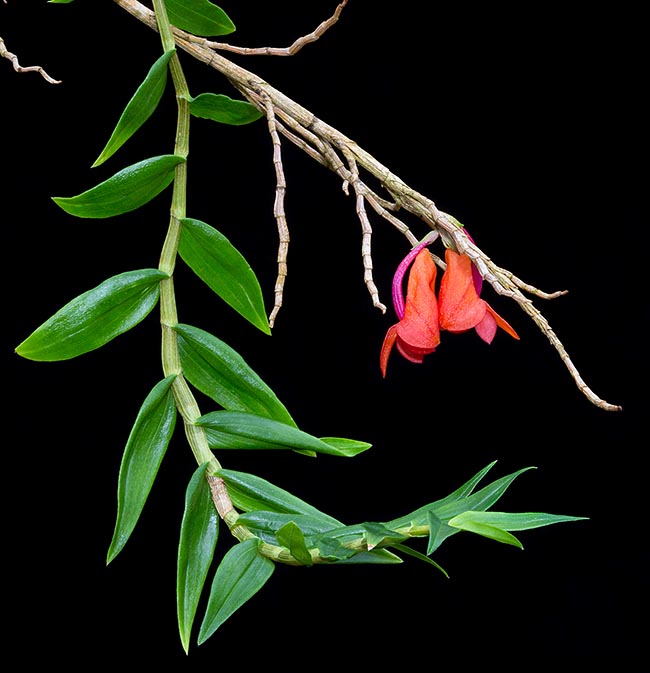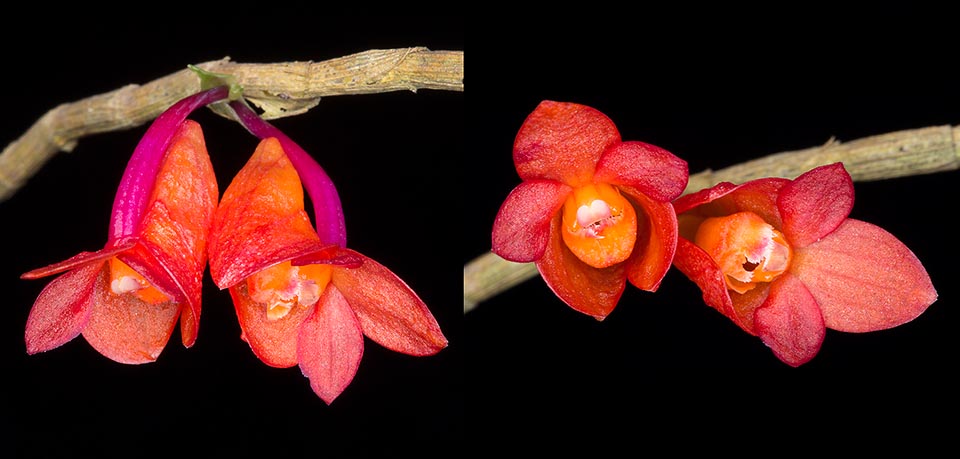Family : Orchidaceae

Text © Pietro Puccio

English translation by Mario Beltramini

Real “glory of the mountains”, as the specific name states, Dendrobium oreodoxa is an epiphyte growing, around 2000 m of altitude, in the mysterious humid pluvial forests of New Guinea © Giuseppe Mazza
The name of the genus is the combination of the Greek substantives “δένδρον” (dendron) = tree and “βίος” (bios) = life, with reference to the numerous species of the genus living on the trees; the specific name is the combination of the Greek substantives “ὄρος” (oros) = mountain and “δόξα” (doxa) = glory, with obvious reference.
Common names: montane dendrobium (English).
The Dendrobium oreodoxa Schltr. (1912) is an epiphytic species with pseudobulbs at times ramified, thin, lithe, up to more than 50 cm long, provided of alternate leaves, distichous, lanceolate with pointed apex, 3-6 cm long and 0,5-1,5 cm broad.
Short racemose inflorescences from the old pseudobulbs bearing 1-3 bright orange red colour flowers of about 2,5 cm of diameter.
Ovary with short pedicel about 2 cm long, ovate sepals about 1 cm long, the two lateral merged at the base to form a sort of conical spur (mentum) 1,3 cm long, oblong-elliptic petals slightly shorter than the sepals, labellum cucullated (shaped like a cap) bent upward with fringed-toothed margin.
It reproduces by seed, in vitro, and division, with each section provided of at least 3-4 pseudobulbs.
Species that stands out due to the long lasting small flowers, about one month, with particularly bright colour, requires a semi-shaded position, intermediate temperatures, 18-28 °C, high humidity, 75-85% and constant movement of the air. Regular waterings so as to maintain almost constantly humid the substratum, but without stagnations, utilizing rain water, demineralized or by reverse osmosis. It may be mounted on trunks or pieces of bark with sphagnum at the base to keep the humidity, like in nature, or cultivated in pots or baskets, even suspended, with a compost that must be particularly aerated and draining formed by medium sliced bark fragments with addition of inerts and sphagnum.

The thin pseudobulbs can exceed the 50 cm. The flowers, here seen from the side and below, last about one month. They rarely exceed the 2,5 cm of diameter © Giuseppe Mazza
The species is reported in the appendix II of CITES (species whose trade is internationally ruled).
Synonyms: Pedilonum oreodoxa (Schltr.) Rauschert (1983); Chromatotriccum oreodoxa (Schltr.) M.A.Clem. & D.L.Jones (2002).
→ For general notions about ORCHIDACEAE please click here.
